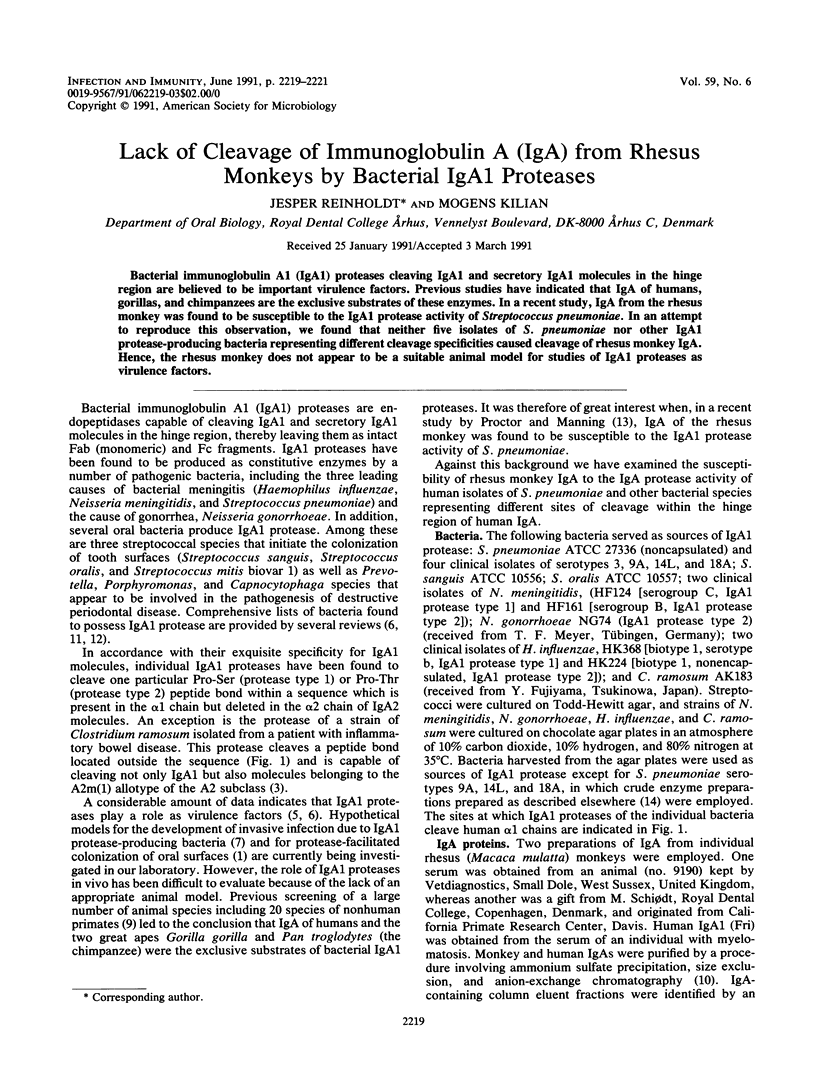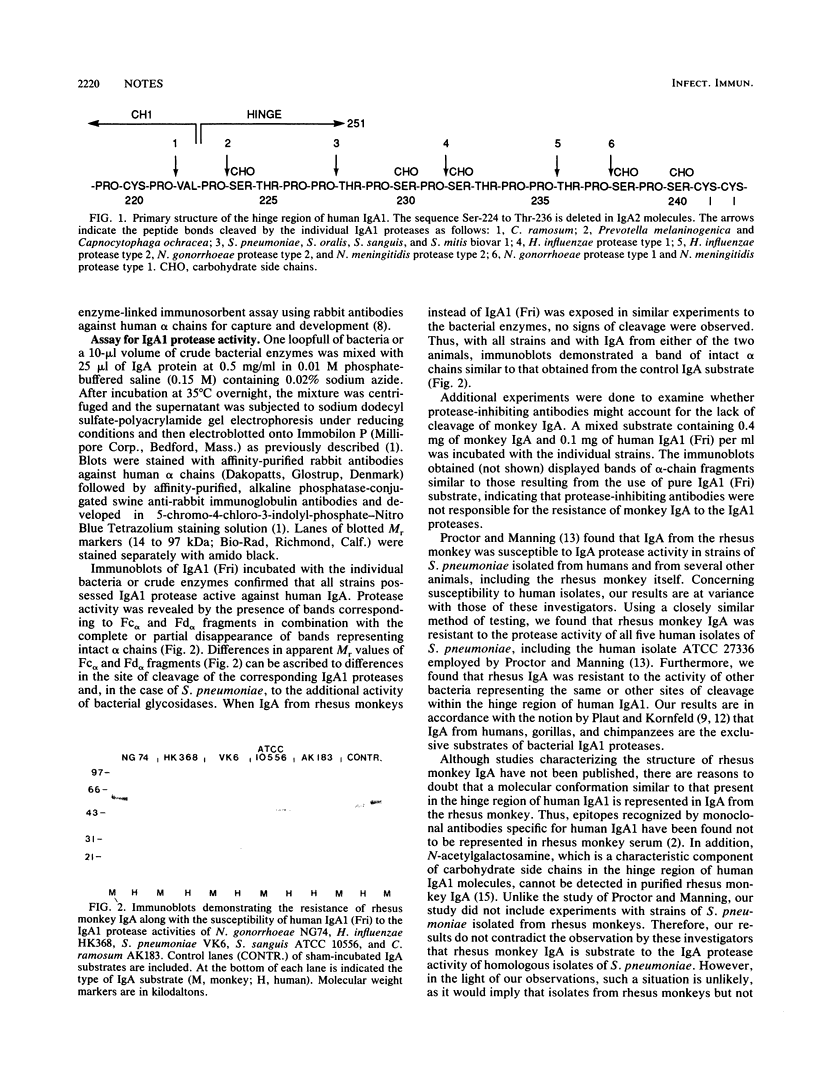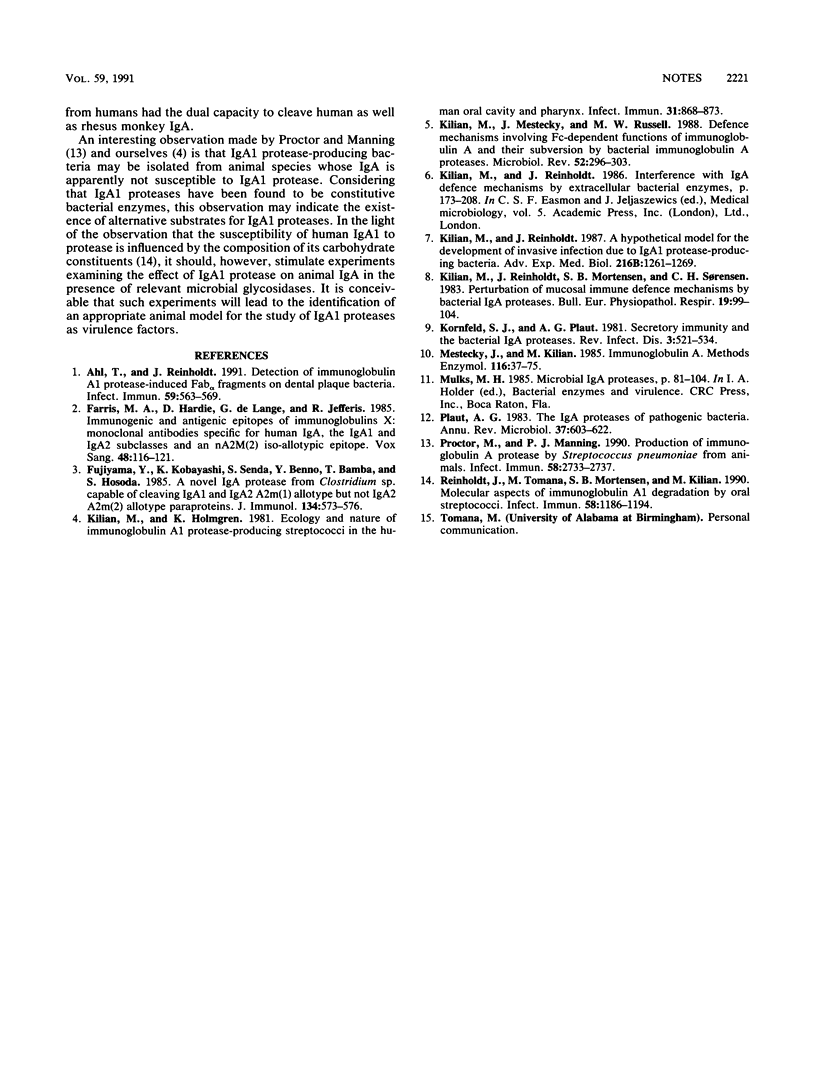Abstract
Bacterial immunoglobulin A1 (IgA1) proteases cleaving IgA1 and secretory IgA1 molecules in the hinge region are believed to be important virulence factors. Previous studies have indicated that IgA of humans, gorillas, and chimpanzees are the exclusive substrates of these enzymes. In a recent study, IgA from the rhesus monkey was found to be susceptible to the IgA1 protease activity of Streptococcus pneumoniae. In an attempt to reproduce this observation, we found that neither five isolates of S. pneumoniae nor other IgA1 protease-producing bacteria representing different cleavage specificities caused cleavage of rhesus monkey IgA. Hence, the rhesus monkey does not appear to be a suitable animal model for studies of IgA1 proteases as virulence factors.
Full text
PDF


Images in this article
Selected References
These references are in PubMed. This may not be the complete list of references from this article.
- Ahl T., Reinholdt J. Detection of immunoglobulin A1 protease-induced Fab alpha fragments on dental plaque bacteria. Infect Immun. 1991 Feb;59(2):563–569. doi: 10.1128/iai.59.2.563-569.1991. [DOI] [PMC free article] [PubMed] [Google Scholar]
- Farris M. A., Hardie D., de Lange G., Jefferis R. Immunogenic and antigenic epitopes of immunoglobulins. X: Monoclonal antibodies specific for human IgA, the IgA1 and IgA2 subclasses and an nA2m(2) iso-allotypic epitope. Vox Sang. 1985;48(2):116–121. doi: 10.1111/j.1423-0410.1985.tb00155.x. [DOI] [PubMed] [Google Scholar]
- Fujiyama Y., Kobayashi K., Senda S., Benno Y., Bamba T., Hosoda S. A novel IgA protease from Clostridium sp. capable of cleaving IgA1 and IgA2 A2m(1) but not IgA2 A2m(2) allotype paraproteins. J Immunol. 1985 Jan;134(1):573–576. [PubMed] [Google Scholar]
- Kilian M., Holmgren K. Ecology and nature of immunoglobulin A1 protease-producing streptococci in the human oral cavity and pharynx. Infect Immun. 1981 Mar;31(3):868–873. doi: 10.1128/iai.31.3.868-873.1981. [DOI] [PMC free article] [PubMed] [Google Scholar]
- Kilian M., Mestecky J., Russell M. W. Defense mechanisms involving Fc-dependent functions of immunoglobulin A and their subversion by bacterial immunoglobulin A proteases. Microbiol Rev. 1988 Jun;52(2):296–303. doi: 10.1128/mr.52.2.296-303.1988. [DOI] [PMC free article] [PubMed] [Google Scholar]
- Kilian M., Reinholdt J. A hypothetical model for the development of invasive infection due to IgA1 protease-producing bacteria. Adv Exp Med Biol. 1987;216B:1261–1269. [PubMed] [Google Scholar]
- Kilian M., Reinholdt J., Mortensen S. B., Sørensen C. H. Perturbation of mucosal immune defence mechanisms by bacterial IgA proteases. Bull Eur Physiopathol Respir. 1983 Mar-Apr;19(2):99–104. [PubMed] [Google Scholar]
- Kornfeld S. J., Plaut A. G. Secretory immunity and the bacterial IgA proteases. Rev Infect Dis. 1981 May-Jun;3(3):521–534. doi: 10.1093/clinids/3.3.521. [DOI] [PubMed] [Google Scholar]
- Mestecky J., Kilian M. Immunoglobulin A (IgA). Methods Enzymol. 1985;116:37–75. doi: 10.1016/s0076-6879(85)16005-2. [DOI] [PubMed] [Google Scholar]
- Plaut A. G. The IgA1 proteases of pathogenic bacteria. Annu Rev Microbiol. 1983;37:603–622. doi: 10.1146/annurev.mi.37.100183.003131. [DOI] [PubMed] [Google Scholar]
- Proctor M., Manning P. J. Production of immunoglobulin A protease by Streptococcus pneumoniae from animals. Infect Immun. 1990 Sep;58(9):2733–2737. doi: 10.1128/iai.58.9.2733-2737.1990. [DOI] [PMC free article] [PubMed] [Google Scholar]
- Reinholdt J., Tomana M., Mortensen S. B., Kilian M. Molecular aspects of immunoglobulin A1 degradation by oral streptococci. Infect Immun. 1990 May;58(5):1186–1194. doi: 10.1128/iai.58.5.1186-1194.1990. [DOI] [PMC free article] [PubMed] [Google Scholar]



